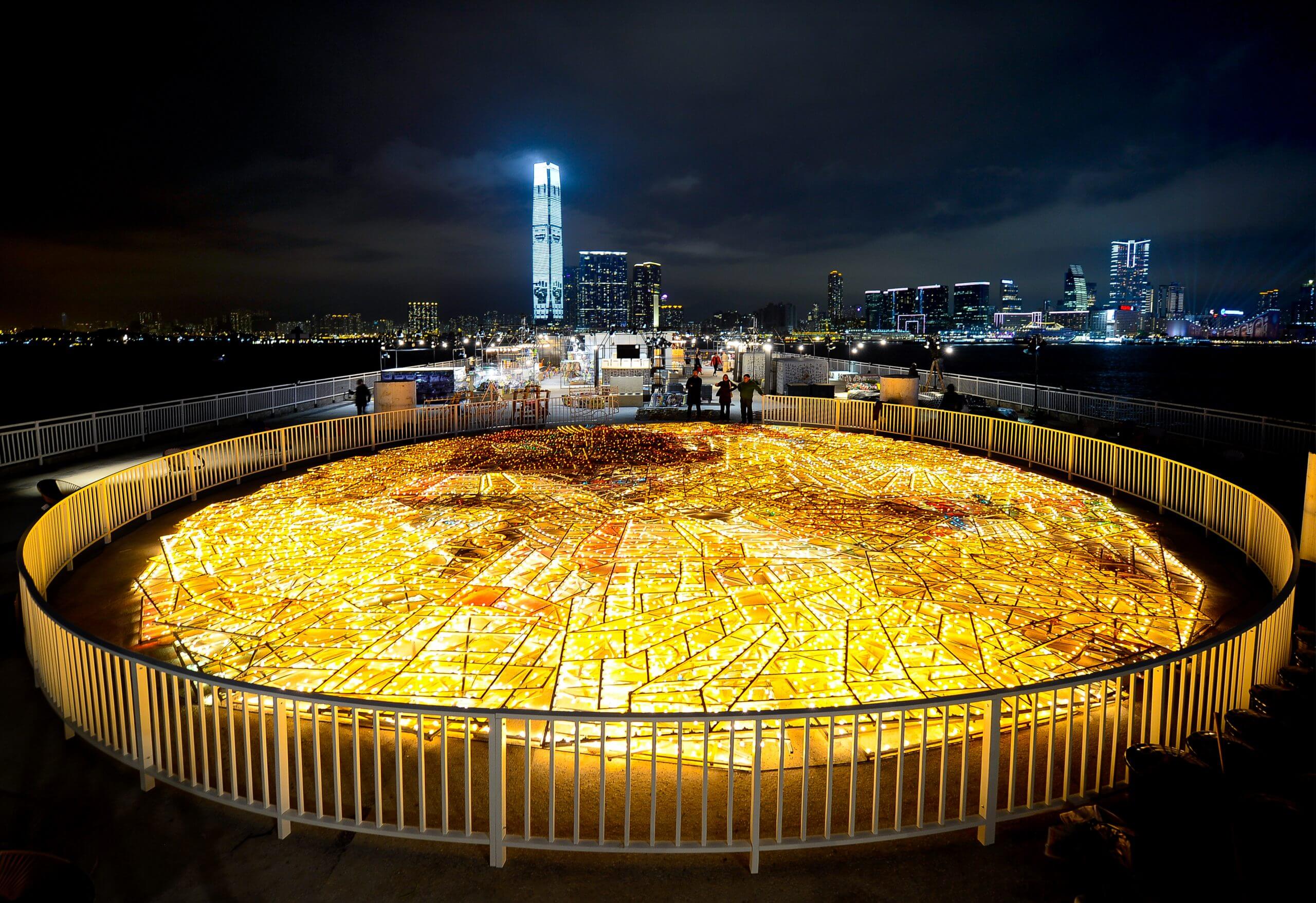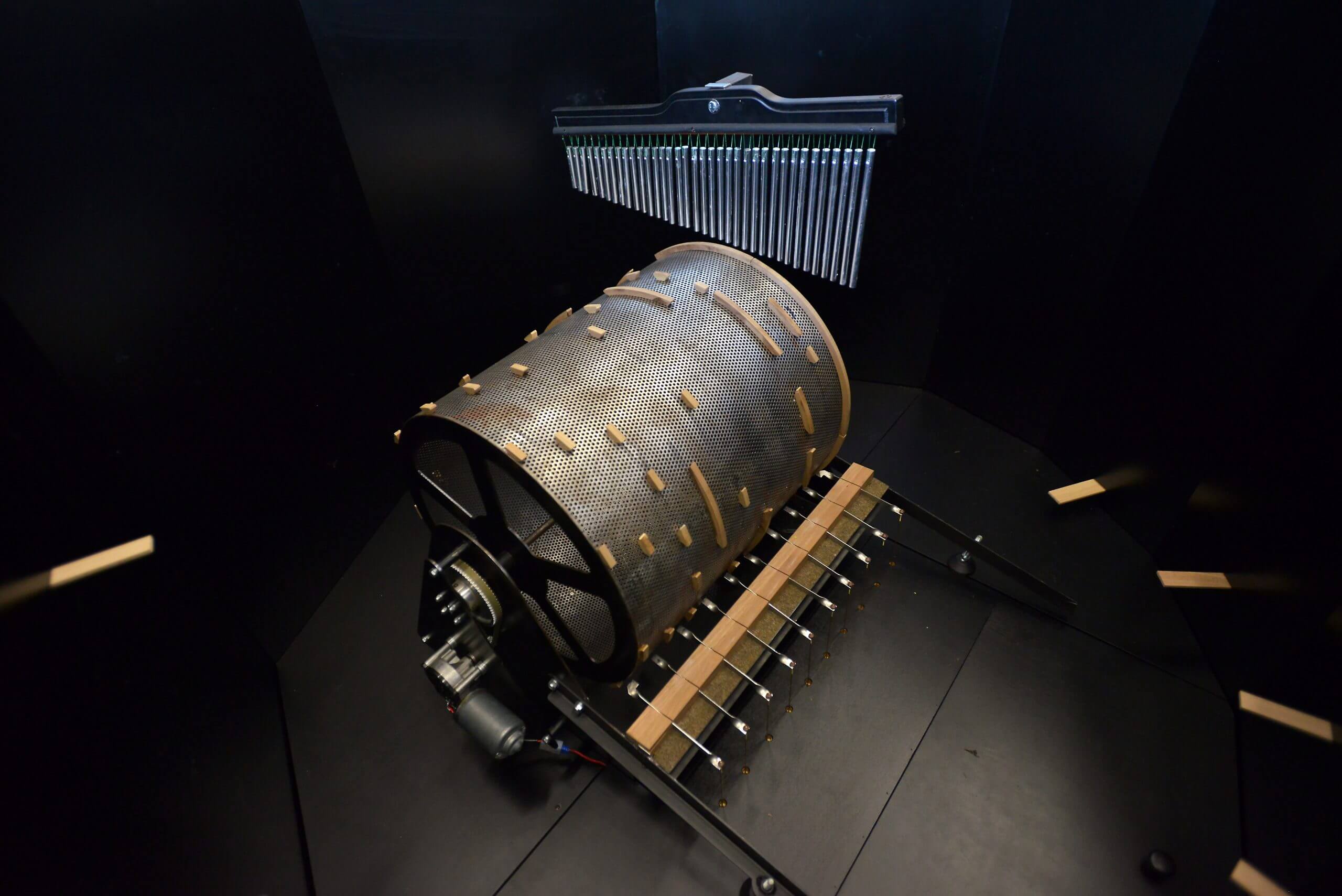From Tuscany to the International Scene: Massimo Bartolini

Massimo Bartolini (b. Cecina, 1962) trained at the Academy of Fine Arts in Florence, Tuscany, and his artistic experimentation took shape through multiple mediums in relation to space and its perception. Works made of lights and shadows, of static and dynamic elements. In 1993, he presented his first exhibition and in Italy alone, he has exhibited at the MART (Rovereto), Merz Foundation (Torino), Marino Marini Museum (Florence), Palazzo Grassi (Venice), and MAXXI (Rome). Elsewhere, he’s exhibited in Bangkok, Buenos Aires, New York, London, Paris and Sofia.
His works speak, have a voice, make themselves felt in their movements. Sometimes they are imperceptible; speak in silence and beyond, they take the user to another dimension in which the senses open up and transport you to another world. Sometimes metaphysical, between materials and sounds to generate a new language, a new reflection and therefore a new meaning. Due (2013) was Bartolini’s installation within the Italian Pavilion, curated by Bartolomeo Pietromarchi, for the 55th Venice Biennale. His 2016 film Black Circle Square won First Prize at the “Now You See Me” Festival hosted at the Louvre (2017). The very suggestive, site-specific installation/performance created at the MAXXI Museum in Rome, Anche Oggi Niente was made up of 150 neon lamps; some of these lights suddenly became shooting stars to highlight the title text.
Bartolini is represented by Massimo de Carlo (Milan/London/Hong Kong) and Frith Street Gallery (London). He began to live off his work “after ten years of activity”, as he explains in this discussion with FRONTRUNNER.

Starless (Hong Kong), 2015-2017
Wood, iron, audio system, lights
16m diamater
Photo credit: Marni
Courtesy of Massimo De Carlo (Milan/London/Hong Kong)
Man, time, space, matter and nature. How much did your Tuscan roots influence your training and artistic production?
So much, I would say. For better or for worse. As a Tuscan, I am used to seeing masterpieces on the street and this is very nice, to become familiar with the masterpiece. The daily masterpiece purged of exceptionality: it is an alienating experience! Those characters you mentioned are all part of my tradition and I only feel better when I can bring them all together into one thing. In some of my works, I have taken on Renaissance images and shapes such as Giotto’s mountains carved in pietra forte (the stone that paves the streets of Florence and which covers many buildings). These small mountains are like motionless performers of an inorganic tableaux vivant. Even the drawings, which are between the landscape and the project that tend to make a space coherent through a system of sentimental proportions, has to do with this type of Tuscan air.
How is a work by Massimo Bartolini conceived and what are the production times?
Some things are thought almost by chance, suddenly, and maybe it takes years to achieve them. While you do them, you keep thinking about them and like in a carousel where thought chases after doing, so fast that they are almost one on top of the other. Many times I start with an incomplete project, waiting to be completed by contingencies, by the encounter with materials. Let’s say that in my work there are works for which I took 1 minute to make them and certain that it takes 30 years!
And which medium do you prefer?
What I need in that moment to do what I want to do, so it can be any material. The material is the other “speaking subject” in the dialectical relationship of doing a job. Affectionately, I am attached to materials such as bricks and alabaster, which among other things were the first materials I used for my works.
Between restoration work on the Anselmetti Chapel (2000) in Torino and projects such as On Identikit (2000) in the Church of the Abbey of Parma and Revolutionary Monk (2015) in the Rucellai Chapel in Florence, what is your relationship with spirituality and the Church? How much do these aspects influence your production?
Coming from an uncultured family, the first stories I heard were those of catechism which fascinated me a lot as a child. For me, the church is not a place where only religion is done, but a place where I go to listen to a certain type of silence, to read a book, to walk. The church is a place that I live in a secular way. Spirituality, on the other hand, does not need mediation. In the Anselmetti Chapel, for example, I placed empty shelves that could be transformed into seats on which people could look at each other and not towards the altar as it usually is. In practice, they sat as the one who administers the cult instead of as the one who is administered. I think this is a clear statement that specifies a particular position of one’s cult, as an idea of emptying one’s soul for an encounter with the other. Revolutionary Monk, on the other hand, is a sculpture of a Burmese monk who would like to make a prayer dangerous, that is, in a “permanent revolution”, at high speed, it becomes a nucleus of menacing and pervading energy. But there is also a reference to Thelonious Monk, who used to dance while rotating on himself during concerts.
Music and poetry. What were you inspired by and how was the Four Organs installation created?
I had been working on pipe organ sculptures for some time. When I was invited to do that show I thought that maybe I could organise a quartet made up of organs that belonged to different experiences and moments. “Four Organs” is also a reference to Steve Reich’s record, which later made me think of a device that could keep the rhythm in the show just like that of the record that has materialized in a Maracas machine. In the end, the orchestration worked: these five sculptures had a voice that harmonised well and the whole exhibition worked a bit like a machine; you entered and there was already something going on, like entering a room where there are people who are already talking. Obviously, the sounds located in precise points of the space meant that the spectator, moving, produced variations in the intensity of the volumes and in the differences in the reverbs so as to make the piece change according to the position.
Among the elements you prefer to use for your works is water, the symbol par excellence of rebirth and purification. You have done various works with waves…
Yes. It is a series of works that have taken on at least three different forms, always with a wave in the center. The wave is a figure of energetic pulsation, a shape whose stability derives from a thrust, a touch, a frequency and a wavelength. It is a precarious shape, but one that expresses the energy that shapes it. The first work dates back to 2000 and is a soliton in a tank: a solitary wave overflows from the basin and irrigates a surrounding barley plantation. This represents with the squandering and the cycle of life. There are two other works, one of which is the series of “Conveyances”: a circular basin with a conical wave inside it surrounded by a bench which represents a place of concentration and meeting, of self-hypnosis. The other work, on the other hand, are tubs or a transport container where the wave breaks against a tree or covers a lamp, it depends. This work was for me the first real encounter with teamwork because many people contributed to its realisation, starting with the curator Carolyn Christov-Bakargiev, the scientist Leone Fronzoni (who followed us to design the wave), then Riccardo Rossi and Yari Mazza. Thanks to this teamwork, I have learned that the works are never yours alone, but that sharing is the founding state of a work in every phase: while you think, while you do, while you show!
What do you think of NFTs? In your opinion, what will the future of the artwork be?
I don’t know much about NFTs, but they seem to me a new merchant expedient to supplant traditional work: it is the grip of the hand, in favour of the reproducible, of the little finger that indicates on the computer keyboard rather than touching and holding something.
Speaking of technology, what is your relationship with social media?
I am generally very distracting and tend to get distracted very easily. At the beginning – out of laziness and now by choice – I am not a member of any platform and then social networks would be a further element of dispersion for me. My work is based a lot on physicality and the relationship in scale with the person and this is not possible with social networks, but I am aware that they are a very interesting linguistic tool, as well as of communication.
They are also a way to control and if the first feature would be very useful to me, the second would be a burden to me. For me, not having social networks is a means of concentration…but sometimes I ask some friends to tell me about people I haven’t seen for a long time. Social networks somehow fill an absence, but I – being very distracted – to feel the presence better, I need the absence. Just as the poet Attilio Bertolucci [father to film directors of Bernardo and Giuseppe] says: “Assenza/ più acuta presenza./ Vago Pensier di te/ vaghi ricordi/ turbano l’ora calma/ e il dolce sole./ Dolente il petto/ti porta,/come una pietra/ leggera.” (Translation: Absence / more acute presence / vague thoughts of you / vague memories / disturbs the calm hour / and the sweet sun. / Aching chest / carries you, / like a stone / lightweight.)

In A Landscape (2017)
Wood, fan, wind, chest, chimes
125 x 190 x 14cm
Photo credit: Stephen White
Courtesy of the artist and Frith Street Gallery (London)
Future projects?
Among the next projects, I will participate in an exhibition at Villa Arson in Nice, then in September my personal show at the [Centro] Pecci Museum in Prato. Later, I will create a work for the Setouchi Triennale in Japan.











Responses